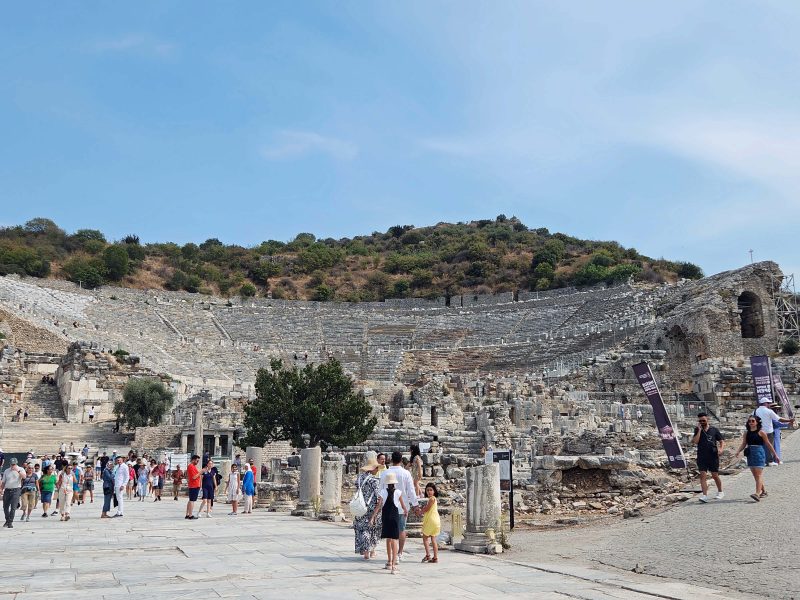Ephesus is one of the best-preserved ancient cities in the world. At one time, the city included one of the Seven Wonders of the Ancient World—the Temple of Artemis, which was destroyed by arson in 356 BC. Ted and I found it far more interesting than the “purposely minimalistic” ruins of Troy.
Ephesus was the fourth largest metropolis of the ancient world, with a population of about 200,000 at its peak. The city is in a major earthquake zone and was destroyed by earthquakes and rebuilt four times. Finally, a massive earthquake, the decline of the harbor, and Arab invasions forced the population of Ephesus to relocate. About 20-30 percent of the ancient city has been excavated, reaching back to the 10th century BC.
We entered the city through the Magnesian Gate at the top of Curetes Street, the main street of Ephesus. The ruins in the photo below used to be shops.

Beyond the shops was a residential area. Jesus’ mother, Mary, lived in a small stone house in Ephesus before she died, and St. John is said to have preached here. St. Paul also lived in Ephesus and wrote his letters to the Ephesians and the Acts of the Apostles here. The buildings shown below are what is left of some Ephesian homes (not Mary’s, St. John’s, or St. Paul’s).


Below you can see Curetes Street. The Aegean Sea used to be at the low end of the street, but silt from the sea has filled in the area. The Aegean Sea is now about three miles beyond the end of the street. Curetes Street was lined with shops, and the columns formerly supported a roof over the street to protect pedestrians from the sun and the rain.

A large portion of Curetes Street is beautifully paved with marble.

Midway along the main street is the façade of the Library of Celsus, the most recognizable building in the city, built to house 12,000 scrolls.

The photo below shows the ruins of Ephesus’ city hall. It looks like it was a beautiful building.

The carving on the stone shown below indicates a hospital.

Here’s a picture of the Great Theater, which seated 25,000 people. Until recently, it was used as a concert venue and hosted Elton John, Ray Charles, Sting, Diana Ross, and many others. In 2018, however, preservationists feared that the volume of concert music would damage the rock (literally rock music?), so the setting was closed to concerts. Quieter public events are still held there.

The stone shown below is an ancient advertisement for a bordello in Ephesus. The left foot carved into the stone meant the brothel was on the left side of the street. To know if it was worth the walk, you could place your left foot in the footprint. If your foot was smaller than the one on the stone, you would be declared underage and denied entry.

At the lower gate of Curetes Street, we saw this assortment of rocks. It looks like a cemetery to me, but this was the site of a gymnasium, an important part of the culture. Gymnasiums (i.e.. schools) were used as educational centers, as places for training in mental and physical activities, and for teaching young men about art, sports, literature, drama, and speech. You can see the Great Theater in the background. Because this gymnasium was built so close to the theater, it is thought to have been used to train theater actors.

Near the end of our walk through Ephesus, a portion of the street was cleared and a theatrical troupe gathered and walked toward a platform in a procession.


At the end of the procession, there was a presentation given in what appeared to be a ceremony (we couldn’t hear the voices well enough to understand them—if they were even speaking in English), and then the “important” people climbed the platform and the others paid homage to them. The performance lasted about 15 minutes and was interesting to watch.

We left Ephesus at the lower gate and finished our day with a drive through the beautiful Turkish countryside.